| View previous topic :: View next topic |
| Author |
Message |
marco campos-venuti

Joined: 09 Apr 2014
Posts: 240
Location: Sevilla



|
 Posted: Sep 29, 2015 09:36 Post subject: Re: About cyclic twinning - (5) Posted: Sep 29, 2015 09:36 Post subject: Re: About cyclic twinning - (5) |
|
|
I guess this also is a cyclic twin.
| Mineral: | Sphalerite triple cyclic twin |
| Locality: | | Stephan Stevanov Mine, Zlatograd, Smolyan Oblast, Bulgaria |  |
|
| Dimensions: | 11 cm |
| Description: |
|
| Viewed: |
26667 Time(s) |
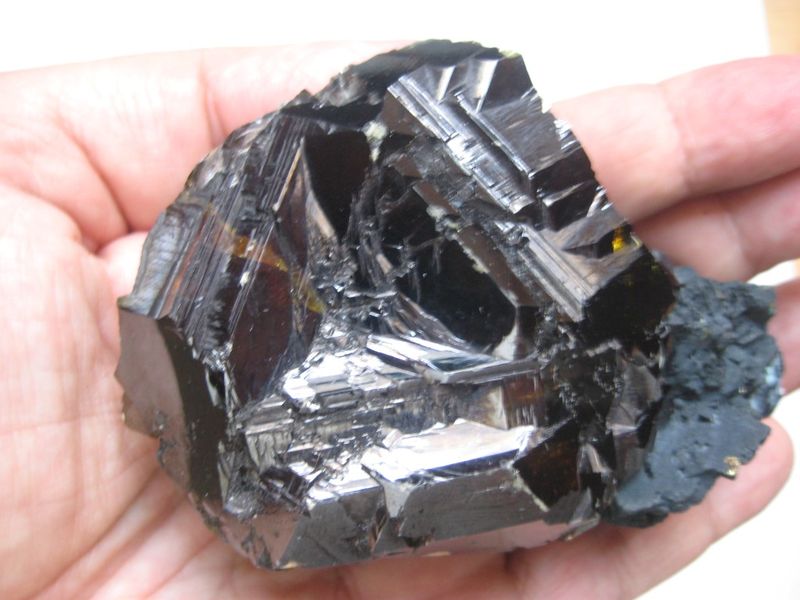
|
|
|
| Back to top |
|
 |
Pete Richards
Site Admin
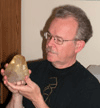
Joined: 29 Dec 2008
Posts: 846
Location: Northeast Ohio



|
 Posted: Sep 29, 2015 10:23 Post subject: Re: About cyclic twinning - (5) Posted: Sep 29, 2015 10:23 Post subject: Re: About cyclic twinning - (5) |
|
|
| RutileFox wrote: | Several contributors to this thread have explained why cyclic-twinned rutile specimens cannot form closed hexagonal loops with six equal sides. Because of their tetragonal structure, cyclic twinned rutile crystals intersect at an angle of about 114 degrees. Complete rutile “sixlings” therefore usually have only five good sides plus a short tail or two.
But six-sided rutile twins do exist!
The secret to this paradox is pseudomorphism. In particular, rutile can assume the orthorhombic structure of brookite, instead of its characteristic tetragonal crystalline structure. Since rutile and brookite have the same chemical composition (titanium dioxide), this special type of pseudomorph is called a “paramorph.”
(snip)
Peter Farquhar
Claremont, California
USA |
It may seem strange to reply to a post from almost two years ago, but Peter's is an interesting post that brings a new perspective to the "rutile sixling" question, and I don't recall having seen it previously. Some aspects of this post bear further discussion.
In typical pseudomorphs and some paramorphs, the (usually numerous) grains of the replacing mineral are randomly oriented, but in some cases the replacing mineral may be oriented by some epitactic relationship between the original mineral and the replacing one. Such an oriented replacement could conceivably produce six sectors related to the six faces on top of the brookite crystal, oriented in twinned orientations - a paramorphic sixling. But there are several reasons why this is highly unlikely.
One is that in order for this to happen, there would have to be a one epitactic relationship between brookite and rutile to govern the orientation of the two faces of the form {120}, pink in the cartoon below, and a second epitactic relationship for the four faces of {111}, in green. And there would have to be a mechanism to "select" the right relationship for each face. Given that the entire brookite crystal has a common structure, it is not clear how this selection could happen.
Furthermore, the symmetry of brookite would allow other "undesired" orientations to occur just as easily. In the cartoon, the arrows are used to suggest an orientation between the rutile and the brookite on each face - they could be thought of as long, thin rutile crystals. The simplest orientation would be the one shown for the pink faces, where the rutile is symmetrically oriented parallel to the midline of the face, and perpendicular to the outer edge of that face.
In order for the outcome of the replacement to be a sixling, the rutile crystals replacing the green regions would have to have the same relationship to the faces, as shown by the black arrows. But this is a different orientation relative to the crystal structure, so it would involve a different epitactic "law". And the symmetry of brookite is such that there is another equivalent orientation in each green face, shown by the grey arrows. It is in fact the orientation that would be desired in the adjacent face in order to produce six-fold symmetry. Replacement beginning at any particular spot would be equally likely to follow either orientation.
The probable result of oriented paramorphy is a mosaic of rutile grains oriented in equivalent but non-parallel directions, without regard for the boundaries between the faces of the crystal, and therefore not forming six sectors twinned to each other.
It is also true that brookite is PSEUDO-hexagonal only. As indicated in the diagram, the angles between the two kinds of faces are not the same as the angles between adjacent faces of the same form, and none of them is 120°. Similarly, the angles between the faces and the c-axis, shown near the top of the second diagram, are not the same for the two kinds of faces. Thus even a replacement that formed six twinned sectors would again be only a pseudo-hexagonal aggregate lacking true 6-fold symmetry.
Finally, a comment about Figure 108 from Bauer. A careful reading of the Howard paper (Rocks and Minerals, vol. 74, no. 2, March/April 1999, pp. 92-102.), which is largely a summary of a translation of Bauer's work, shows that this figure is intended to show how a true cyclic rutile twin could be confused with a paramorph after brookite - it is not an illustration of a paramorph per se, nor does it have the symmetry of brookite.
| Description: |
|
| Viewed: |
26530 Time(s) |
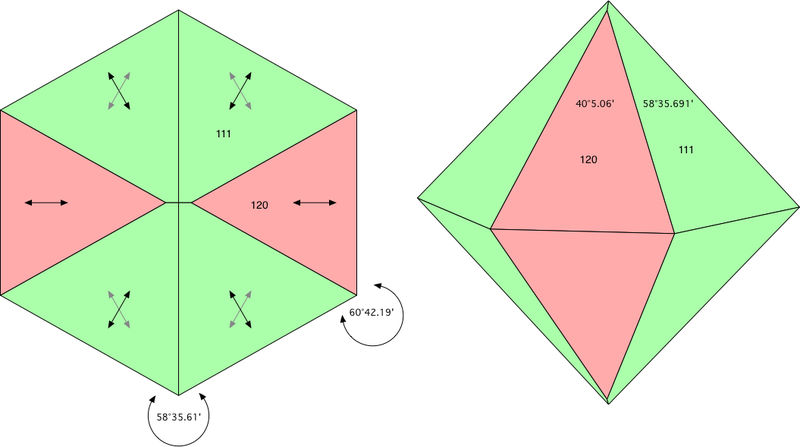
|
_________________
Collecting and studying crystals with interesting habits, twinning, and epitaxy |
|
| Back to top |
|
 |
Pete Richards
Site Admin

Joined: 29 Dec 2008
Posts: 846
Location: Northeast Ohio



|
 Posted: Sep 29, 2015 11:23 Post subject: Re: About cyclic twinning - (5) Posted: Sep 29, 2015 11:23 Post subject: Re: About cyclic twinning - (5) |
|
|
| marco campos-venuti wrote: | | I guess this also is a cyclic twin. |
The textbooks say that sphalerite has twinning with the twin axis [111], which is a three-fold symmetry axis. But the usual meaning of twinning on a given axis is that the top part of a crystal (relative to that axis) is rotated 180° with respect to the bottom half.
The symmetry of sphalerite includes a three-fold axis of rotation. Consequently, the three parts of your specimen appear to be related by a symmetry operation that is already part of the crystal structure. One of the rules of twinning is that twins cannot form by operation of a symmetry element that is part of the inherent structure. So I would say, no, this is not a twin.
It is possible, but unlikely, that the three parts of your crystal are related by three-fold rotation about some axis that is other than [111]. If so, the twinning is due to a twin "law" that is not reported in the standard textbooks.
Twin or not, it is an attractive specimen.
_________________
Collecting and studying crystals with interesting habits, twinning, and epitaxy |
|
| Back to top |
|
 |
marco campos-venuti

Joined: 09 Apr 2014
Posts: 240
Location: Sevilla



|
 Posted: Sep 29, 2015 12:26 Post subject: Re: About cyclic twinning - (5) Posted: Sep 29, 2015 12:26 Post subject: Re: About cyclic twinning - (5) |
|
|
Thanks Pete for your knowledge. I usually tend to imagine a twin when I see a concave edge with a no-casual orientation. Isn't enough?
marco
|
|
| Back to top |
|
 |
Pete Richards
Site Admin

Joined: 29 Dec 2008
Posts: 846
Location: Northeast Ohio



|
 Posted: Sep 29, 2015 15:35 Post subject: Re: About cyclic twinning - (5) Posted: Sep 29, 2015 15:35 Post subject: Re: About cyclic twinning - (5) |
|
|
That's a pretty good indication, but sometimes the minerals play tricks on us! Parallel growths and cleavage in some minerals can lead to grooves, hollows, and other concave features that we don't expect to see on crystals, but they are not twins.
_________________
Collecting and studying crystals with interesting habits, twinning, and epitaxy |
|
| Back to top |
|
 |
Peter Farquhar
Site Admin

Joined: 14 May 2011
Posts: 52
Location: Virginia



|
 Posted: Aug 05, 2020 14:11 Post subject: Re: About cyclic twinning - (5) Posted: Aug 05, 2020 14:11 Post subject: Re: About cyclic twinning - (5) |
|
|
After a long sabbatical, I’m ready to continue the discussion on cyclic twinning. Let me begin by thanking Pete Richards for his detailed reply in 2015 to my post two years earlier about twinning in rutile paramorphs after brookite from Magnet Cove. In reviewing his reply, I discovered a careless mistake that needs to be corrected.
On October 26, 2013, I inadvertently posted photos of the rutile paramorph (PF-1960) instead of the correct photo of the rutile sixling (PF-2402), which is the real ex-Kimzey piece described in the text of my post. I regret mixing up the labels on these two rutile specimens.
Unfortunately, the rutile specimen (PF-1960) is a simple paramorph after brookite; it does not have the features of a rutile sixling depicted in the illustrations by Bauer (1891), Smith (2007), Howard (1999), and others.
As Pete Richards pointed out, Bauer’s Figure 1 (see below) was “intended to show how a true cyclic rutile twin could be confused with a paramorph after brookite.” Howard (1999, p. 97) also notes, “The rutile sixlings that mimic pseudo-hexagonal dipyramidal paramorphs after brookite may be difficult to distinguish from simple paramorphs of the same general form.”
Identifying rutile sixlings from Magnet Cove
Nevertheless, I question Pete Richards’ conclusion that the existence of a paramorphic rutile sixling twin is “highly unlikely.”
Bauer (1891) identified a few features of rutile sixlings (Rutilsechslinge) that distinguish them from other rutile paramorphs after brookite from Magnet Cove. Williams (1891, pp. 317-330) further elaborates on Bauer’s findings and discusses related research addressing such critical distinctions.
For instance, Bauer’s Figure 1 shows a top-down view of a rutile sixling to illustrate a series of linear grooves, or “surface striations” (Flächenstreifung). Each series of striations runs parallel to one of the six base edges of the pseudo-hexagonal dipyramid (or “apparent dihexahedron” in Bauer’s terms). Bauer noted that each series of striations is indicative of twinning in that sector.
Bauer’s Figure 1 illustrates another distinctive feature of rutile sixlings from Magnet Cove. The following translation of Bauer (1891, pp. 226-227) discusses “systems of oriented bars (Leisten)” that appear on some of the faces of rutile sixlings.
“In nature, these rutile crystals are either formed with all six individual faces or there are fewer of them, e.g., only II, III, and IV (Fig. 1), so that the crystal grew up with a wide area at the point where the three other individual faces should be. … Raised above the faces g, which form the apparent dihexahedron (Fig. 1), are numerous elongated narrow straight bars, which generally run parallel to particular polar edges of the apparent dihexahedron. Each surface g thus carries, or at least can carry, two systems of such bars, which may intersect many times, such as on individuals II or IV, or do not meet, as on III.
The raised bars on each such face g are delimited at the top by a flat surface which is parallel to the abutting face with which the former face g forms a common edge, another polar edge, and a base edge of the apparent dihexahedron (e.g., the bars designated III on g4 are bounded by a face parallel to g3 at the top, etc.) These narrow bars are aligned in exactly the same direction as the abutting faces g with which they are parallel. …
These bars are not always as regular as in the Figure; sometimes they are not exactly parallel to the edge in question, or they may form rough surface on a face of the apparent dihexahedron by several bars pressing together. Nevertheless, the system of those rutile bars to whom they are parallel according to the above can always be seen. This phenomenon is sometimes somewhat modified, especially in the case of smaller crystals.”
In summary, a key in identifying rutile sixlings from Magnet Cove that have the pseudo-hexagonal dipyramidal forms is to look for parallel striations and systems of oriented bars as illustrated in Bauer’s Figure 1. The striations run parallel to the base edges of the pyramids, and appear on all faces if the rutile is a complete cyclic twin. At the same time the systems of oriented bars confirm the presence of twinning, they also often result in rough surfaces “caused by the extension of rutile crystals through the twin faces” (Howard (1999)). In contrast, simple rutile paramorphs after brookite usually have somewhat smoother faces than the rutile sixlings.
Examples of rutile sixlings from Magnet Cove
Art Smith and Mike Howard (2016, p. 33) note that rutile sixling twins are “rare but still are occasionally recovered” from the Magnet Cove Rutile Company deposit. This deposit is a half mile away from Richardson Farm, where collecting in the late 1800s uncovered the finest rutile paramorphs and sixling twins ever found at Magnet Cove. Many of these rutile and brookite specimens were sent to Europe for further research and crystallographic analysis until the Richardson Farm site was exhausted in the 1890s.
The following two examples of rutile sixling twins were collected from the fields of the Richardson Farm in Magnet Cove, Arkansas, around 1875-1880. Both specimens are pseudo-hexagonal dipyramids and display the parallel striations and systems of oriented bars illustrated in Bauer’s Figure 1.
The first sixling twin of rutile after brookite (PF-2402) is the Kimzey Family piece found around 1880 and whose provenance was detailed in my earlier post (q.v.). Compare the highlighted face in the photo of PF-2402 with the face g3 in Bauer’s Figure 1. Note that both specimens exhibit multiple striations parallel to edge III, as well as a system of oriented bars of type II that are parallel to the polar edge common to faces g3 and g2.
The second sixling twin of rutile after brookite (PF-2245) is from Albert E. Foote (1846-1895), the well-known mineral dealer from Philadelphia, Pennsylvania, who collected many rutile and brookite specimens at Magnet Cove in 1875. This rutile paramorph is a cluster of three small pseudo-hexagonal dipyramids, each showing the characteristic parallel striations and systems of oriented bars. It is a triple sixling twin of a rutile paramorph after brookite.
It is instructive to compare the highlighted face in the photo of PF-2245 with the face g3 in Bauer’s Figure 1. Both exhibit multiple striations parallel to edge III. Moreover, the highlighted face of specimen PF-2245 exhibits one “elongated narrow straight bar” of type IV, and one large rough bar of type II formed by the “pressing together” of several narrow rutile bars. Once again, as Bauer noted, “These narrow bars are aligned in exactly the same direction as the abutting faces g with which they are parallel.”
Conclusions
Although relatively scarce, paramorphic rutile sixlings after brookite (like PF-2402 and PF-2245) from Magnet Cove, Arkansas USA do indeed exist. Such rutile sixlings captivated the attention of many scientists in the late 1800s, and still fascinate collectors today.
Twinning in rutile is a very active research topic. Material scientists and others have been using high-resolution transmission electron microscopy and other advanced equipment to study the formation mechanisms of rutile twinning in real time. Over the past two decades, insights into nonclassical crystal growth have revolutionized our understanding of cyclic twinning in rutile and other minerals – which may be a topic for further discussion in this thread or elsewhere.
Acknowledgements
My thanks to J. Michael (Mike) Howard, former geologist and field mineralogist for the Arkansas Geological Survey, for sharing his expertise about rutile sixlings from Magnet Cove. My thanks also to Keegan Johnson of the U.S. Geological Survey Library in Reston, Virginia for locating several research papers written in German and published in the mid to late 1800s. Any errors in the German translations or otherwise are my responsibility.
References
Bauer, Max (1891). “Ueber die Paramorphosen von Rutil nach Brookit von Magnet Cove, Arkansas.” Beitrage zur Mineralogie, VII Reihe, 14 in Neues Jahrbuch fur Minerologie, Geologie und Palaeontologie, vol. 1, pp. 217-232.
Howard, J. Michael (1999). “Brookite, Rutile Paramorphs after Brookite, and Rutile Twins from Magnet Cove, Arkansas,” Rocks and Minerals, vol. 74, no. 2, March/April 1999, pp. 92-102.))
Smith, Arthur E. Jr., (2007). “Magnet Cove Rutile Sixlings and Eightlings,” The Backbender’s Gazette, November 2007, pp. 4-8.
Smith, Arthur E. Jr., and Howard, J. Michael (2016). Magnet Cove, Hot Spring County, Arkansas: Collector and Professional Observations, Stories, and Photographs of Minerals from this Classic Mineral Collecting Locality. Published as an electronic book available at:
http://rockhoundingar.com/download/Magnet%20Cove_Smith&Howard.pdf
(link normalized by FMF)
Williams, J. Francis (1891). The Igneous Rocks of Arkansas: Annual Report of the Geological Survey of Arkansas for 1890, Volume II.
| Mineral: | Rutile sixling (drawing published in 1891) |
| Locality: | | Magnet Cove, Hot Spring County, Arkansas, USA |  |
|
| Description: |
| Sketch of a rutile sixling paramorph after brookite published in 1891 by Max Bauer in "Ueber die Paramorphosen von Rutil nach Brookit von Magnet Cove, Arkansas," Beitrage zur Mineralagie, VII Reihe, 14, in Neues Jahrbuch fur Mineralogie, Geologie, und Paleontologies, Bd. 1, Tafel 5, Figure 1. |
|
| Viewed: |
20483 Time(s) |
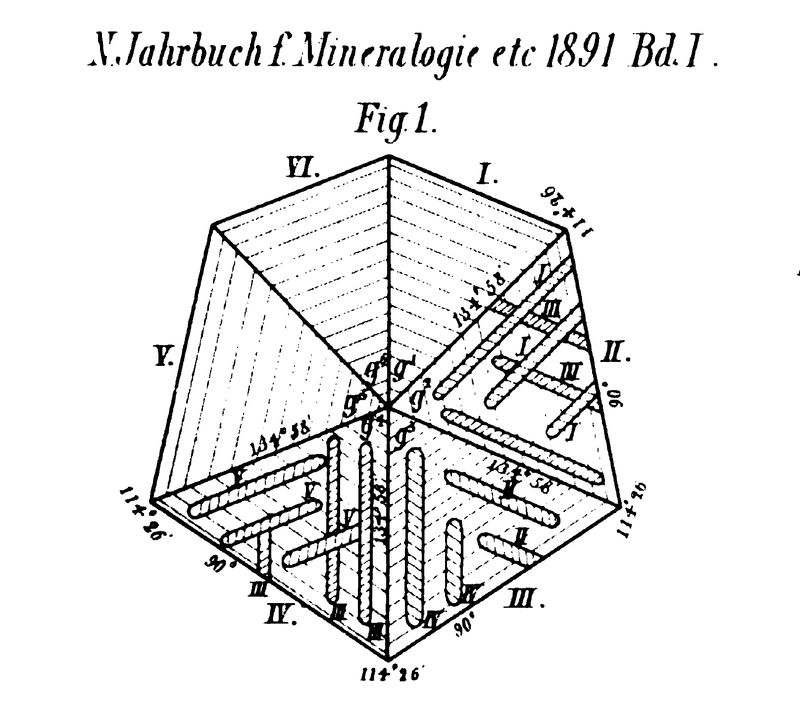
|
| Mineral: | Rutile sixling paramorph after brookite (PF-2402) |
| Locality: | | Richardson Farm, Magnet Cove, Hot Spring County, Arkansas, USA |  |
|
| Dimensions: | 1.9 x 1.9 x 1.9 cm |
| Description: |
| Found by William and Hodge Kimzey around 1880 in a plowed field at the Richardson Farm on the north side of Cove Creek in Magnet Cove, Arkansas. |
|
| Viewed: |
20473 Time(s) |
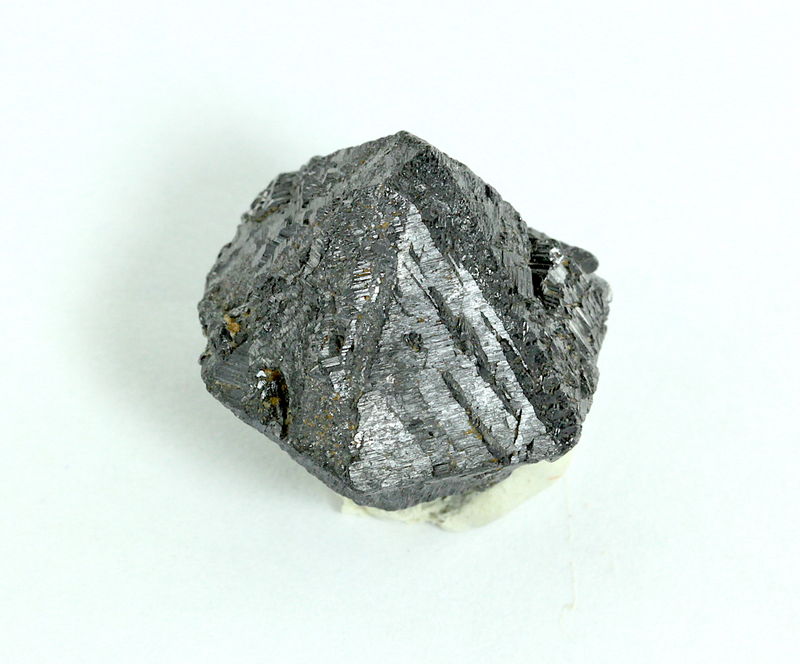
|
| Mineral: | Rutile sixling paramorph after brookite -- largest crystal in a cluster of three (PF-2245) |
| Locality: | | Richardson Farm, Magnet Cove, Hot Spring County, Arkansas, USA |  |
|
| Dimensions: | Main crystal shown is 1.1 x 1.0 x 0.7 cm; entire cluster is 2.0 x 1.3 x 0.7 cm |
| Description: |
| Rare triple sixling. Found by Dr. A. E. Foote around 1875 from the Richardson Farm in Magnet Cove, Arkansas. |
|
| Viewed: |
20514 Time(s) |
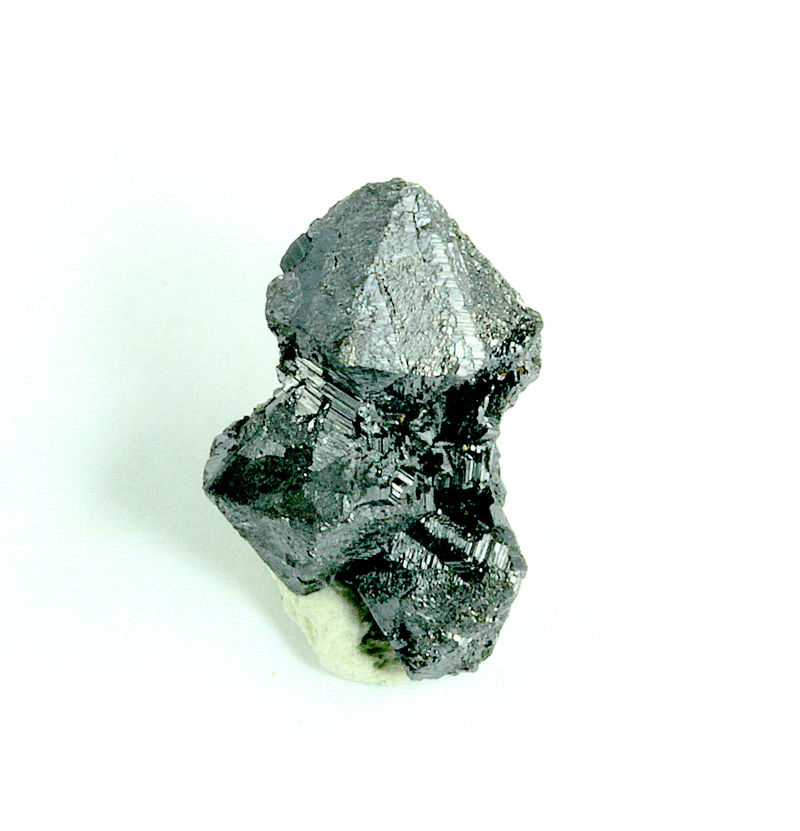
|
|
|
| Back to top |
|
 |
Kevin Conroy

Joined: 03 Dec 2018
Posts: 78
Location: Saint Louis, Missouri


|
 Posted: Aug 05, 2020 22:48 Post subject: Re: About cyclic twinning - (5) Posted: Aug 05, 2020 22:48 Post subject: Re: About cyclic twinning - (5) |
|
|
Peter, I think that this is one of the most well written and referenced posts that I’ve seen. You’ve obviously written this because of a deep interest in these beauties.
However, I disagree with the conclusion that the specimens that you’ve pictured and described are rutile sixling paramorphs of brookite. I believe they are indeed rutile paramorphs of brookite. Just because they retained the six-fold shape of the brookite crystals doesn’t make them rutile sixlings. This would be the same as saying that a calcite after a pseudohexagonal aragonite paramorph is a calcite sixling. It is merely a pseudomorph in the shape of the original mineral, with the same composition as the original crystal caused by a phase transformation (which is the definition of a paramorph).
|
|
| Back to top |
|
 |
Peter Lemkin
Joined: 18 Nov 2016
Posts: 403
Location: Prague


|
 Posted: Aug 06, 2020 10:17 Post subject: Re: About cyclic twinning - (5) Posted: Aug 06, 2020 10:17 Post subject: Re: About cyclic twinning - (5) |
|
|
| This is really a first class thread I just stumbled upon! I have many sixling cyclic twinned rutiles [mostly from CZ] and some other cyclic twined minerals. May this thread go on and on and on.....as it is fascinating and I'm learning a lot from it.
|
|
| Back to top |
|
 |
Bob Morgan
Joined: 18 Jan 2018
Posts: 254
Location: Savannah, Georgia



|
 Posted: Aug 09, 2020 12:02 Post subject: Re: About cyclic twinning - (5) Posted: Aug 09, 2020 12:02 Post subject: Re: About cyclic twinning - (5) |
|
|
Recently I looked at my rutile sixling from Arkansas and noticed many irregularities. So this thread grabbed my attention.
Looking at it again the paramorph theory seems to be the best explanation. The whole crystal seems to be strained with blocky structures. There is one bar on a face that is actually a step down from one side to the other. From the upper surface there is a surface parallel to the adjacent face, then a thin surface parallel to the host face, then another step down to the surface of the host face. This is in the middle of the host face with ends of the bar where the surface of the host splits and then comes back together.
I suspect this resulted from a transition from the imperfections that happened with the paramorphing from brookite to rutile followed by some further rutile overgrowth contributing to larger blocks.
By the way, fluorite "spinel' twins have hexagonal profiles that are from the intergrowth of two crystals. The twin boundaries wander around across the large octahedral faces even though twinning on the (111) between the two crystals is the only law involved.
|
|
| Back to top |
|
 |
Kevin Conroy

Joined: 03 Dec 2018
Posts: 78
Location: Saint Louis, Missouri


|
 Posted: Aug 09, 2020 14:28 Post subject: Re: About cyclic twinning - (5) Posted: Aug 09, 2020 14:28 Post subject: Re: About cyclic twinning - (5) |
|
|
Bob, the Magnet Cove rutile sixlings/eightlings/sixteenlings and paramorphs definitely look different. If you could post a photo of yours I could give you my opinion of which it is.
Here's a rather poor photo of an eightling twin of mine.
| Mineral: | Rutile |
| Locality: | | Arkansas, USA |  |
|
| Dimensions: | 13 x 12 x 8 mm |
| Description: |
|
| Viewed: |
20155 Time(s) |
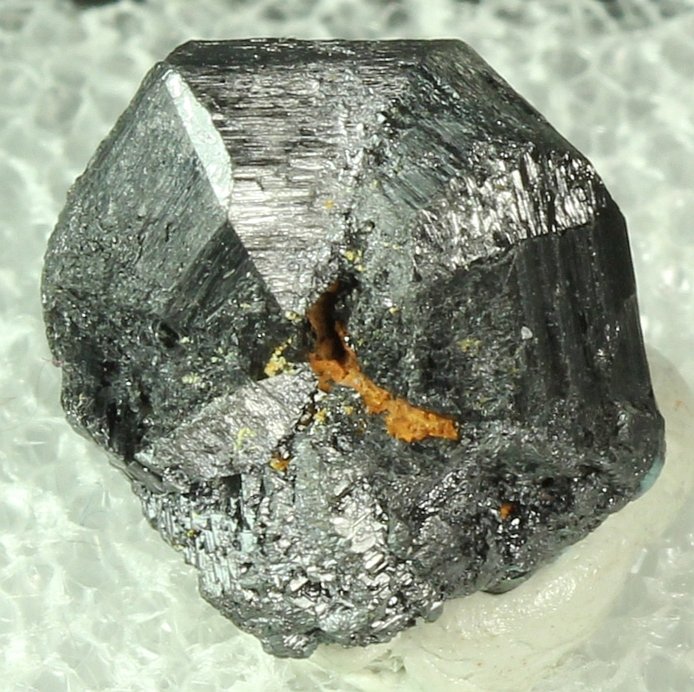
|
|
|
| Back to top |
|
 |
Don Lum

Joined: 03 Sep 2012
Posts: 2924
Location: Arkansas



|
|
| Back to top |
|
 |
Kevin Conroy

Joined: 03 Dec 2018
Posts: 78
Location: Saint Louis, Missouri


|
 Posted: Aug 09, 2020 22:29 Post subject: Re: About cyclic twinning - (5) Posted: Aug 09, 2020 22:29 Post subject: Re: About cyclic twinning - (5) |
|
|
Don, thank you for posting these. The three specimens on the right side of the top row are superb, and clearly show the cyclic twinning that the Magnet Cove rutiles are famous for. I added stars on these twins.
The specimen on the left side of the third row (that is pictured at least once more on the page) might be a twin. It's hard to say on this one with seeing more angles. In my opinion the rest of the specimens are not twins.
I've included a photo of your page so it's easier to reference the specimens that I mentioned. However, I hope everyone goes to your page so they can see all of the specimens in full detail.
| Description: |
|
| Viewed: |
20153 Time(s) |
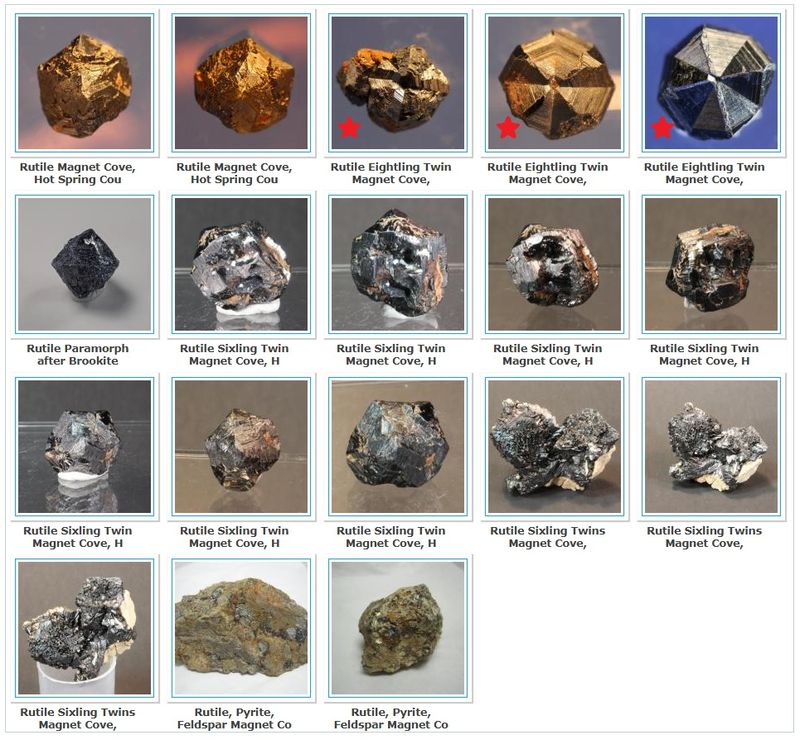
|
|
|
| Back to top |
|
 |
Don Lum

Joined: 03 Sep 2012
Posts: 2924
Location: Arkansas



|
 Posted: Aug 09, 2020 23:07 Post subject: Re: About cyclic twinning - (5) Posted: Aug 09, 2020 23:07 Post subject: Re: About cyclic twinning - (5) |
|
|
Thank you, Kevin. I appreciate your comments and agree.
Take care.
Don
_________________
hogwild |
|
| Back to top |
|
 |
James Catmur
Site Admin

Joined: 14 Sep 2006
Posts: 1489
Location: Cambridge



|
 Posted: Aug 10, 2020 01:45 Post subject: Re: About cyclic twinning - (5) Posted: Aug 10, 2020 01:45 Post subject: Re: About cyclic twinning - (5) |
|
|
I have approached the museum again to see if they can help us. Is it a hole or a dimple?
| Peter Farquhar wrote: | Is it a hole or a dimple?
Several times in this thread, Pete Richards and others have challenged the accuracy of old crystallographic models showing a hole in the middle of a cyclic twinned rutile (e.g., see James’ recent photo of a Copenhagen museum displaying a zig-zag donut-shaped wooden model next to a rutile eightling from Magnet Cove, Arkansas).
It's a fascinating question, "Do real cyclic twinned rutile specimens exist with a hole completely through center of the crystal (rather than a dimple that ends at depth)?" So far, we’ve seen all dimples and no holes.
|
|
|
| Back to top |
|
 |
Don Lum

Joined: 03 Sep 2012
Posts: 2924
Location: Arkansas



|
|
| Back to top |
|
 |
|





